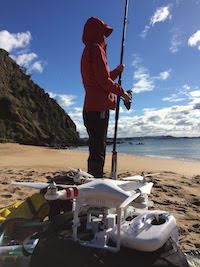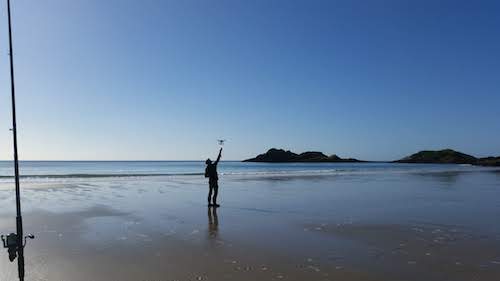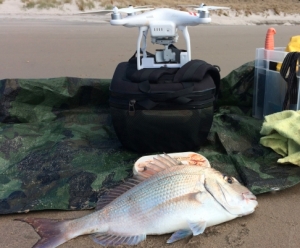So you decided to give drone fishing a try? Good choice.
Drone fishing is an exciting new fishing method for shore-based anglers.
The increased casting distance that can be achieved with a drone will lead to better catches, more strikes and less wasted time and bait.
Imagine casting your bait out from the beach for hundreds of meters and dropping it right over a fishing hole.
You can cast out bigger baits, better present your bait and use minimal sinker weight. You could never achieve this with a surfcasting outfit.
The more natural presentation of your bait - right in the target zone - will lead to more strikes and bigger fish.

So that all sounds really good. Almost too good to be true.
Of course, there are also a few downsides to drone fishing.
As with everything in life, there are pros and cons. But I believe the pros outweigh the cons in this case.
Nevertheless, let's look at a few cons. One of the cons would be the need of having to buy an expensive drone. A cheap drone won't have the required GPS functions, lifting capacity and control range required for drone fishing. Another con would be the very real risk of losing the expensive drone due to some unforeseen line tangles, technical failures or piloting errors.
Getting a waterproof drone that is made specifically for fishing could reduce this risk somewhat. But crashing it 500 meters offshore could still mean that you will probably never see it again, even if it’s waterproof and floats.
Another con is that you might not be allowed to fly a drone wherever and whenever you want. People get annoyed by drones. Drones, weekends and busy beaches don’t match well.

So after these considerations, let's have a look at what’s needed to get into drone fishing.
The first thing obviously would be a drone.
There are only a few suitable drones available. The thing they all have in common is a relatively high price tag.
The most expensive drones are those that are specifically made for fishing, such as the splash drone.
The splash drone is waterproof and has a build-in release mechanism for dropping your baits.
If those specialised fishing drones seem a bit too expensive, the next best choice would be a DJI Phantom.
The phantoms are not waterproof but have otherwise a very good lifting capacity and a control range of over 1 kilometre.
The advantage here is that there are many used ones around and you could pick up a slightly older second-hand model for far less money.
Unfortunately, the phantom drones don’t have a build-in bait release mechanism.
It’s possible to buy them aftermarket or - if you’re technically-minded - to build one yourself.
Other drones on the market could be used for fishing. But the above two options are the best in my opinion.
If money is not so much of an issue then I would recommend the splash drone for sure.
And no matter which drone you get. You’ll need at least one or two spare batteries.
Drones don't fly for long. The DJI can fly for about 20 minutes on one charge. It’s enough for 3-4 longer casts. With two batteries you’ll get 6-8 casts.
It doesn’t seem a lot. But because you can fish in more productive water, it’s usually enough to catch fish.
The next things you need are a suitable rod and reel.
If you already have a surfcasting outfit then you could probably use that.
The biggest consideration is that the reel needs to have a very large line capacity. You need a minimum of 500 meters of line in my opinion.
If the reel is spooled up with a braided fishing line it will hold more line than with mono.
Fishing with a braided line on a long-distance is also much more fun, as there is no stretch in the line and you can feel every bite.
For that reason, I would not use a monofilament line for drone fishing.
So I would recommend a large capacity surfcasting reel, preferably with a free-spool function such as a Shimano bait runner, spooled with 30-50lbs braided line.
Or even better a big overhead reel (Shimano tld25) with 30-50lbs braided line. With an overhead reel, the chances of line tangles and resulting drone crashes are much reduced. The bigger reels can hold a high capacity of fishing line. Make sure to get a reel that can hold at least 500 meters of braided line.
The downside of an overhead reel is that it’s not very good for old fashioned casting. So if you’re looking for a multi-purpose reel, a surfcasting reel is a bit more versatile and can also be used for beach fishing, rock fishing, boat fishing, etc.
So far we got a drone with a release mechanism, a nice big reel with around 700 meters of 30lbs braided line.
Next, we need a rod. I normally use just a standard 10-foot surfcasting rod. Although you don’t need a surfcasting rod for drone fishing, a long rod is better at keeping your line above the waves when flying out your baited drone. Larges waves crashing down on your line with the drone still attached could easily lead to a quick, unplanned end of your drone fishing career.
So for surf beaches, I'm using a long surfcasting rod. And for calm beaches, it doesn't matter so much and a shorter rod can be used.
You just gotta make sure that the rod is strong enough to land some potentially very big fish.
Now you have a drone, a suitable reel and a rod. Ah, life is good.
Next, you need a rod holder or beach spike. You only got two hands.
Once you’re ready to fly out your bait, you won't have a free hand to hold your rod.
So make sure you either got a keen helper or perhaps - a bit more reliably - a rod holder.
To get things started it’s best to keep the rigging simple.
You can just start with a simple two hook dropper rig. Attach it directly to the braided line with a uni to uni knot.
Use a medium grapnel sinker and put some tasty bait on the hooks. Same as you would do when surfcasting.
Now you have the rod in your rod holder, you got your rig ready and the hooks are all baited.
Ready to start up the drone. Actually, it’s best to already turn it on while you bait the hooks.
The motors need a little time to warm up before you can fly.
Once the drone is ready, start it and fly it to the edge of the water. Take your baited hooks. Have your reel in free-spool or at minimum drag and walk with the hooks towards the drone. Control the height of the drone with the controller in your other hand.
Try to fly the drone high enough so that you can just reach it with outstretched arms to attach your bait.
I just use a little bit of bend wire that I attach to the sinker. The bent end of the wire just kinda hangs over the bolt of the release mechanism.
As soon as I hang the wire onto the release mechanism I fly the drone up and make sure that it’s pulling the line easily.
If everything looks good I walk back to my rod so I can keep an eye on the reel.
Then I fly the drone about half speed forward to wherever I want to drop the bait. Usually around 300 meters offshore.
Try not to fly the drone too fast as this could result in line loops and tangles. You want a constant slow pull on your line with just a little tension to prevent tangles.
At 300 meters out you can hardly see the drone. But you’ll feel a tuck on the rod when you open the release mechanism and the bait falls into the water. Then I just hit the "return to home" button on the drone. It will come back automatically. While it’s on its way back, I wind in some slack line.
I’ll land the drone manually once it’s back overhead and turn it off. Then I’m back on the rod, waiting for bites.
Once you hook up you gotta reel in over 300 meters of line. It takes a bit of time - but it's totally exciting, especially with a good fish on the other end.
I hope this little introduction to drone fishing has helped somewhat to better understand how it can be done.
A lot is going on when getting started with drone fishing. Flying the drone and taking care of the hooks and line may not sound so complicated, but it can be quite a handful on the first few tries.

As with everything after a bit of practice, you get more and more comfortable with the whole setup and everything becomes streamlined and easier to control. It certainly is a lot of fun and you won't get bored easily when you fish with a drone.
We also released a whole bunch of videos about drone fishing on youtube - so please check them out if you want to learn more about drone fishing.
you can also check out this forum post about drone fishing if you would like to ask some questions

No comments yet. Be the first to comment!